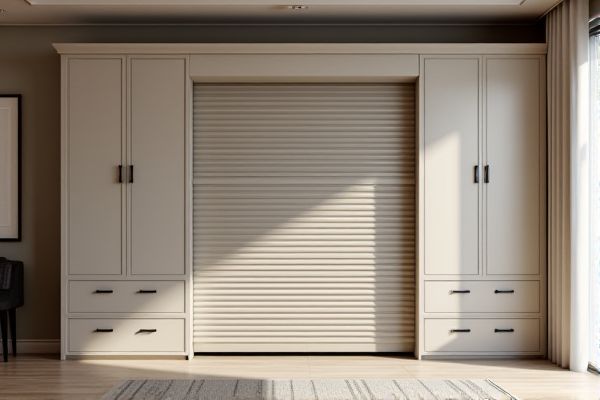
A roller cabinet offers mobility and flexibility for your workspace, allowing tools to be easily transported to different areas, while a stationary cabinet provides a stable, space-saving storage solution ideal for permanent setups. Discover which option best suits your needs and work environment by reading the rest of the article.
Table of Comparison
| Feature | Roller Cabinet | Stationary Cabinet |
|---|---|---|
| Mobility | Highly portable with wheels for easy movement | Fixed position, designed to stay stationary |
| Use Case | Ideal for workshops requiring frequent relocation | Best suited for permanent setups and heavy-duty storage |
| Storage Capacity | Moderate; optimized for tool organization | Higher capacity; accommodates larger tools and equipment |
| Durability | Robust but lighter materials to support mobility | Heavier, more durable construction for stability |
| Cost | Typically more expensive due to mobility features | Generally lower cost, fewer moving parts |
| Surface | Often has flat top for working on the go | May include larger work surfaces or integrated benches |
Introduction to Roller and Stationary Cabinets
Roller cabinets offer mobility with heavy-duty casters, enabling you to easily move tools and equipment around your workspace for enhanced flexibility. Stationary cabinets provide a fixed storage solution, ensuring stability and maximizing space efficiency in a designated area. Choosing between roller and stationary cabinets depends on your specific organizational needs and the dynamic of your workspace.
Key Differences Between Roller and Stationary Cabinets
Roller cabinets offer mobility with built-in casters, allowing users to easily move tools around a workspace, enhancing flexibility and efficiency. Stationary cabinets, anchored in place, provide increased stability and higher weight capacity for heavy-duty storage needs. The choice depends on workspace dynamics, with roller cabinets favored in dynamic environments and stationary cabinets preferred for fixed, organized tool storage.
Advantages of Roller Cabinets
Roller cabinets offer superior mobility compared to stationary cabinets, allowing easy transportation of tools across various job sites or work areas. Their sturdy wheels and compact design provide convenience without sacrificing storage capacity, enabling efficient organization and accessibility. These features enhance productivity by reducing time spent retrieving tools and improving workspace flexibility.
Benefits of Stationary Cabinets
Stationary cabinets offer superior stability and enhanced security for storing heavy tools and equipment, making them ideal for workshops with limited mobility needs. They provide ample storage space with robust construction, ensuring durability and long-term use in demanding environments. Choosing a stationary cabinet ensures your tools remain organized and easily accessible without the risk of movement or tipping.
Mobility and Accessibility Comparison
Roller cabinets offer superior mobility, allowing you to easily transport tools and equipment across your workspace, while stationary cabinets remain fixed in one location, providing stable and secure storage. Accessibility in roller cabinets is enhanced by smooth-rolling casters and swivel wheels that facilitate movement even in tight spaces. Stationary cabinets provide consistent access to tools in a dedicated spot, minimizing retrieval time when mobility is not a priority.
Storage Capacity and Organization
Roller cabinets offer flexible storage capacity with multiple drawers allowing for organized separation of tools and materials, which enhances portability and quick access. Stationary cabinets generally provide larger, fixed storage volumes designed for bulkier items, featuring shelves or compartments that maximize vertical space utilization. Both types optimize workspace efficiency, but roller cabinets excel in modular organization while stationary cabinets are suited for high-capacity, stable storage solutions.
Durability and Material Considerations
Roller cabinets typically feature heavy-duty steel construction with reinforced corners and durable casters designed for mobility in industrial environments, while stationary cabinets prioritize thicker steel panels and welds for enhanced stability and long-term structural integrity. High-quality powder-coated finishes on both types resist corrosion and wear, but stationary cabinets often include additional weight-bearing shelves and robust locking mechanisms to secure tools during extended storage. Material considerations such as gauge thickness, caster quality, and reinforcement methods directly impact the durability and lifespan of roller versus stationary tool cabinets in professional workshops.
Space and Placement Requirements
Roller cabinets offer exceptional flexibility due to their mobility, allowing users to easily reposition them for optimal workspace efficiency and access, which is ideal for dynamic environments with limited space. Stationary cabinets, while offering stable storage, require a fixed location and more dedicated floor space, making them suitable for areas with ample room and less need for frequent rearrangement. Choosing between the two depends on workspace layout, mobility needs, and the available square footage.
Ideal Use Cases for Each Cabinet Type
Roller cabinets are ideal for workshops and garages where mobility and easy access to tools are essential, allowing you to move your storage solution close to your work area. Stationary cabinets are best suited for fixed workspaces or industrial settings where heavy-duty, stable storage is required for organizing tools and equipment securely. Choosing the right cabinet depends on whether your primary need is portability or a permanent, robust storage solution.
Choosing the Right Cabinet for Your Needs
Selecting between a roller cabinet and a stationary cabinet depends largely on your workspace mobility requirements and storage preferences. Roller cabinets offer portability with durable wheels for ease of movement, ideal for dynamic environments or tasks requiring frequent tool access across areas. Stationary cabinets provide stable, often larger storage solutions suited for fixed workstations where security and minimal movement are priorities, ensuring your tools remain organized and easily accessible.
 homyna.com
homyna.com